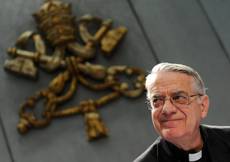Smoke better than texting to announce new pope
'Suspense part of beauty of event' says Lombardi
12 March, 14:59
(By Giovanna Chirri).
(ANSA) - Vatican City, March 12 - Tradition is better than technology to announce that the 266th pontiff has been chosen, a Vatican spokesman said before the start of the conclave to elect Benedict XVI's successor on Tuesday. Conclave watchers should be waiting for white smoke drifting out of the Sistine chapel's chimney and the sound of ringing church bells rather than expecting a text message. ''A minimum of suspense is part of the beauty of this event, I don't promise to send a text at that moment'', said Father Federico Lombardi.
Father Lombardi, a spokesman for Benedict XVI since 2006, has over the past few weeks been helping the international media to understand the Church and its bi-millennial tradition, the mechanisms to elect the pope, which are technical yet enveloped in the fascination of secrecy. He has answered technical doubts, made theological clarifications, and responded to questions on mysteries and peculiar details. The 85-year-old Benedict XVI, now pope emeritus, resigned on February 28 on the grounds that he no longer had the mental and physical strength to lead the world's 1.2 billion Catholics.
He was the first pope in 600 years to abdicate.
Overall, the Vatican spokesman has invested in transparency, common sense and competence in responding to the media - the same ingredients with which he has explained how votes of the 115 cardinal-electors taking part in the secret conclave in the Sistine Chapel are counted. Lombardi explained the process by comparing it to the meetings of religious orders to choose their superiors. A Jesuit, Lombardi is attuned to the election of the Jesuits' ''black pope'', as the head of the largest and one of the most influential Catholic orders is known. The voting mechanism to elect a pontiff follows certain steps, Lombardi explained. First cardinal-electors - who are all under 80 as cardinals over that age are not eligible to vote - cast their first ballot according to their priorities and expectations. A number of names usually emerge from the first vote or round of votes. However, cardinals understand fairly quickly which candidates are gathering more consensus and choose one from this first selection. At this point, votes start converging on a name. This process can reportedly be rather fast.
Such a process loses part of its mystery when the procedure is explained. Never before has the public opinion followed this closely - through the Internet, Twitter and Facebook - the selection of the next pope since Benedict XVI's shock announcement on February 11 that he would step down.
Thanks to modern technologies, Vatican watchers can follow the conclave, have their word on the quality of cardinal-electors and question the state of health of the Catholic Church worldwide.
Does this mean that information on the Church is becoming more democratic? According to German theologian Peter Huenermann, this could be ''the most difficult conclave in the last century as it takes place under the eye of so many interlocutors''.
Historians Alberto Melloni and Pino Ruggieri cited the ''puritanism of the media'' which judges the morality of cardinal-electors. An example is the case involving the Archbishop of Edinburgh Keith O'Brien who decided not to take part in the conclave after the media reports accusing him of having abused young men who were studying to be priests in the 1980s.
Ever since the beginning on Monday last week of the general congregations, Father Lombardi warned journalists against reporting a ''conclave of the media'' which has very little to do with the real conclave. The general congregations are daily meetings which enable the cardinals to get to know each other better and share ideas about what characteristics the next leader of the Catholic Church should have.
Over the past centuries, leading powers influenced the selection of a pontiff. Could the power of the media exercise a similar influence? The Vatican has the role of shedding light on secrecy, of explaining how it works by making naturally reserved procedures transparent. The media on the other hand must try and understand so they can tell the story. Looking at the colour of smoke drifting out the Sistine Chapel's chimney is quite an experience. A pilgrim, an intellectual, a reporter, an agnostic, an onlooker or a tourist can live the experience in total freedom, feel the emotions and store the memories. It's a matter of smoke against a text message, reality against a virtual world. (giovanna.chirri@ansa.it)











